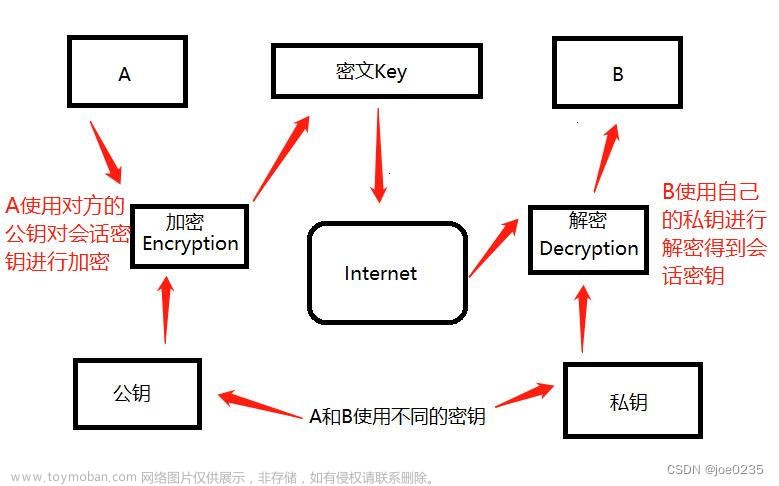非对称加密算法中,提供一个公钥一个私钥。一般情况下,采用公钥加密、私钥解密的方式。
假设有这样一个场景:服务A与服务B需要通信,通信内容为了安全需要进行加密传输,并且服务A与服务B不能互相持有对方的钥匙。文章来源:https://www.toymoban.com/news/detail-510925.html
我首先想到的是能否利用RSA实现双向的加解密,查阅了资料后做了一个简单的实现,下面贴出实现原理及代码:文章来源地址https://www.toymoban.com/news/detail-510925.html
public class RsaEncryptUtil{
public static final String PUBLIC_KEY="publicKey";
public static final String PRIVATE_KEY="privateKey";
private static final String KEY_STORE = "JKS";
private static final int MAX_ENCRYPT_LENGTH = 117;
private static final int MAX_DECRYPT_LENGTH = 128;
/**
* 随机生成RAS公钥与私钥字符串,直接返回
*/
public static Map<String, String> getKeys() {
KeyPairGenerator keyPairGen;
try {
keyPairGen = KeyPairGenerator.getInstance("RSA");
} catch (NoSuchAlgorithmException e) {
e.printStackTrace();
throw new RSAException("RSA获取钥匙对失败", e);
}
// 初始化密钥对生成器,密钥大小为96-1024位
keyPairGen.initialize(1024,new SecureRandom());
// 生成一个密钥对,保存在keyPair中
KeyPair keyPair = keyPairGen.generateKeyPair();
Map<String,String> keyMap = new HashMap<>();
keyMap.put(PUBLIC_KEY, RSACryptUtil.base64ToStr(keyPair.getPublic().getEncoded()));
keyMap.put(PRIVATE_KEY, RSACryptUtil.base64ToStr(keyPair.getPrivate().getEncoded()));
return keyMap;
}
/**
* 获得KeyStore
*
* @param keyStorePath
* @param password
*/
private static KeyStore getKeyStore(String keyStorePath, String password) throws Exception {
FileInputStream is = new FileInputStream(keyStorePath);
KeyStore ks = KeyStore.getInstance(KEY_STORE);
ks.load(is, password.toCharArray());
is.close();
return ks;
}
/**
* 由KeyStore获得私钥
*
* @param keyStorePath KeyStore路径
* @param alias 别名
* @param storePass KeyStore访问密码
* @param keyPass 私钥的钥匙密码
*/
private static PrivateKey loadPrivateKey(String keyStorePath, String alias, String storePass, String keyPass) throws Exception {
KeyStore ks = getKeyStore(keyStorePath, storePass);
PrivateKey key = (PrivateKey) ks.getKey(alias, keyPass.toCharArray());
return key;
}
/**
* 由Certificate获得公钥
*
* @param keyStorePath KeyStore路径
* @param alias 别名
* @param storePass KeyStore访问密码
*/
private static PublicKey loadPublicKey(String keyStorePath, String alias, String storePass) throws Exception {
KeyStore ks = getKeyStore(keyStorePath, storePass);
PublicKey key = ks.getCertificate(alias).getPublicKey();
return key;
}
/**
* 公钥加密
*
* @param publicKey 公钥
* @param content 明文数据
*/
public static String encryptByPublic(String publicKey, String content){
if (StringUtils.isEmpty(publicKey)) {
throw new RSAException("加密公钥为空, 请设置");
}
if(StringUtils.isEmpty(content)){
throw new RSAException("加密明文为空, 请设置");
}
Cipher cipher;
StringBuilder result = new StringBuilder();
try {
// 使用默认RSA
cipher = Cipher.getInstance("RSA");
cipher.init(Cipher.ENCRYPT_MODE, RSACryptUtil.loadPublicKey(publicKey));
byte[] bytes = content.getBytes();
for (int i = 0; i < bytes.length; i += MAX_ENCRYPT_LENGTH) {
byte[] subarray = ArrayUtils.subarray(bytes, i, i + MAX_ENCRYPT_LENGTH);
if(subarray != null && subarray.length > 0){
byte[] doFinal = cipher.doFinal(subarray);
result.append(RSACryptUtil.base64ToStr(doFinal));
}
}
return result.toString();
} catch (NoSuchAlgorithmException e) {
throw new RSAException("无此加密算法",e);
} catch (NoSuchPaddingException e) {
e.printStackTrace();
return null;
} catch (InvalidKeyException e) {
throw new RSAException("加密公钥非法,请检查",e);
} catch (IllegalBlockSizeException e) {
throw new RSAException("明文长度非法",e);
} catch (BadPaddingException e) {
throw new RSAException("明文数据已损坏",e);
} catch (Exception e) {
throw new RSAException("未知错误",e);
}
}
/**
* 私钥解密
*
* @param privateKey 私钥
* @param content 密文数据
*/
public static String decryptByPrivate(String privateKey, String content){
if (StringUtils.isEmpty(privateKey)) {
throw new RSAException("解密私钥为空, 请设置");
}
if(StringUtils.isEmpty(content)){
throw new RSAException("解密密文为空, 请设置");
}
if(content.length() < 4){
throw new RSAException("解密密文有误:" + content);
}
Cipher cipher;
StringBuilder result = new StringBuilder();
try {
// 使用默认RSA
cipher = Cipher.getInstance("RSA");
cipher.init(Cipher.DECRYPT_MODE, RSACryptUtil.loadPrivateKey(privateKey));
byte[] bytes = RSACryptUtil.strToBase64(content);
for (int i = 0; i < bytes.length; i += MAX_DECRYPT_LENGTH) {
byte[] subarray = ArrayUtils.subarray(bytes, i, i + MAX_DECRYPT_LENGTH);
if(subarray != null && subarray.length > 0){
byte[] doFinal = cipher.doFinal(subarray);
result.append(new String(doFinal));
}
}
return result.toString();
} catch (NoSuchAlgorithmException e) {
throw new RSAException("无此解密算法",e);
} catch (NoSuchPaddingException e) {
e.printStackTrace();
return null;
} catch (InvalidKeyException e) {
throw new RSAException("解密私钥非法,请检查");
} catch (IllegalBlockSizeException e) {
throw new RSAException("密文长度非法",e);
} catch (BadPaddingException e) {
throw new RSAException("密文数据已损坏",e);
} catch (Exception e) {
e.printStackTrace();
throw new RSAException("未知错误",e);
}
}
/**
* 私钥加密
*
* @param privateKey 私钥
* @param content 明文数据
*/
public static String encryptByPrivate(String privateKey,String content){
if (StringUtils.isEmpty(privateKey)) {
throw new RSAException("加密私钥为空, 请设置");
}
if(StringUtils.isEmpty(content)){
throw new RSAException("加密明文为空, 请设置");
}
Cipher cipher;
StringBuilder result = new StringBuilder();
try {
// 使用默认RSA
cipher = Cipher.getInstance("RSA");
cipher.init(Cipher.ENCRYPT_MODE, RSACryptUtil.loadPrivateKey(privateKey));
byte[] bytes = content.getBytes();
for (int i = 0; i < bytes.length; i += MAX_ENCRYPT_LENGTH) {
byte[] subarray = ArrayUtils.subarray(bytes, i, i + MAX_ENCRYPT_LENGTH);
if(subarray != null && subarray.length > 0){
byte[] doFinal = cipher.doFinal(subarray);
result.append(RSACryptUtil.base64ToStr(doFinal));
}
}
return result.toString();
}catch (NoSuchAlgorithmException e) {
throw new RSAException("无此加密算法",e);
} catch (NoSuchPaddingException e) {
e.printStackTrace();
return null;
} catch (InvalidKeyException e) {
throw new RSAException("加密私钥非法,请检查",e);
} catch (IllegalBlockSizeException e) {
throw new RSAException("明文长度非法",e);
} catch (BadPaddingException e) {
throw new RSAException("明文数据已损坏",e);
}
}
/**
* 公钥解密
*
* @param publicKey 公钥
* @param content 密文数据
*/
public static String decryptByPublic(String publicKey, String content){
if (StringUtils.isEmpty(publicKey)) {
throw new RSAException("解密公钥为空, 请设置");
}
if(StringUtils.isEmpty(content)){
throw new RSAException("解密密文为空, 请设置");
}
if(content.length() < 4){
throw new RSAException("解密密文有误:" + content);
}
Cipher cipher;
StringBuilder result = new StringBuilder();
try {
// 使用默认RSA
cipher = Cipher.getInstance("RSA");
cipher.init(Cipher.DECRYPT_MODE, RSACryptUtil.loadPublicKey(publicKey));
byte[] bytes = RSACryptUtil.strToBase64(content);
for (int i = 0; i < bytes.length; i += MAX_DECRYPT_LENGTH) {
byte[] subarray = ArrayUtils.subarray(bytes, i, i + MAX_DECRYPT_LENGTH);
if(subarray != null && subarray.length > 0){
byte[] doFinal = cipher.doFinal(subarray);
result.append(new String(doFinal));
}
}
return result.toString();
}catch (NoSuchAlgorithmException e) {
throw new RSAException("无此解密算法",e);
} catch (NoSuchPaddingException e) {
e.printStackTrace();
return null;
} catch (InvalidKeyException e) {
throw new RSAException("解密公钥非法,请检查",e);
} catch (IllegalBlockSizeException e) {
throw new RSAException("密文长度非法",e);
} catch (BadPaddingException e) {
throw new RSAException("密文数据已损坏",e);
}
}
}到了这里,关于RSA双向加解密(公钥加密-私钥解密;私钥加密-公钥解密)的文章就介绍完了。如果您还想了解更多内容,请在右上角搜索TOY模板网以前的文章或继续浏览下面的相关文章,希望大家以后多多支持TOY模板网!











